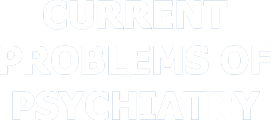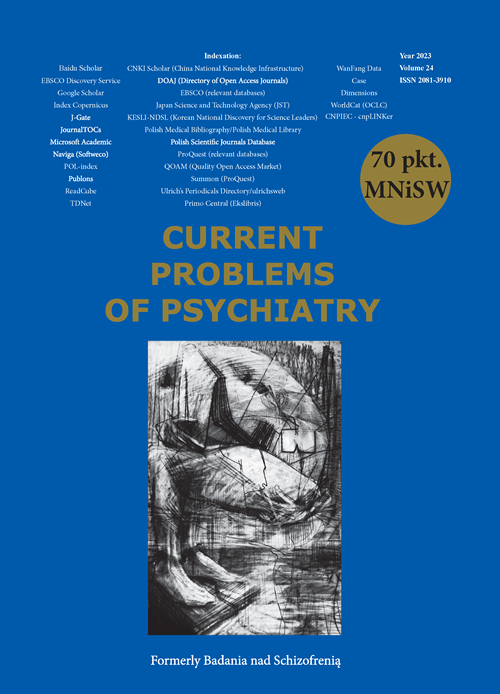Skuteczność przezczaszkowej stymulacji magnetycznej w leczeniu uzależnienia od alkoholu - artykuł przeglądowy
DOI:
https://doi.org/10.12923/2353-8627/2023-0019Słowa kluczowe:
leczenie, alkoholizm, przezczaszkowa stymulacja magnetyczna, psychiatria biologicznaAbstrakt
Wstęp: Uzależnienie od alkoholu jest częstym problemem zdrowotnym, niosącym ze sobą wiele negatywnych konsekwencji. Ze względu na niesatysfakcjonujące wyniki dotychczasowego leczenia podejmuje się badania nad nowymi formami terapii. Jedną z takich metod jest przezczaszkowa stymulacja magnetyczna. Technika ta polega na oddziaływaniu polem magnetycznym
na ośrodkowy układ nerwowy. Kolejne impulsy magnetyczne dostarczane są z określoną częstotliwością powodując depolaryzację neuronów. Takie powtarzalne oddziaływanie pozwala na długotrwałe modulowanie pobudliwości korowej, a tym samym może prowadzić do określonych efektów klinicznych. W niniejszej pracy omówiono doniesienia dotyczące leczenia uzależnienia od alkoholu z wykorzystaniem przezczaszkowej stymulacji magnetycznej. Uwzględniono zarówno prace dotyczące konwencjonalnej powtarzalnej przezczaszkowej stymulacji magnetycznej, stymulacji theta burst oraz głębokiej przezczaszkowej stymulacji magnetycznej.
Materiał i metoda: Na podstawie przeszukania baz bibliograficznych PubMed i Science Direct wybrano 12 badań opublikowanych w latach 2010-2022. Wyniki zestawiono w formie tabeli, aby w sposób przejrzysty porównać różnice w zakresie parametrów stymulacji, jej lokalizacji, a także skuteczności zastosowanej interwencji.
Dyskusja: Porównano wyniki wybranych prac. Wskazano na różnice metodologii i omówiono problem wysokiego wskaźnika rezygnacji (tzw. dropout rate) w badaniach nad uzależnieniami.
Wnioski: Aktualnie brak wystarczających dowodów, by rekomendować stosowanie przezczaszkowej stymulacji magnetycznej w leczeniu uzależnienia od alkoholu. Rezultaty dotychczas przeprowadzonych badań są zróżnicowane. Wynika to między innymi z wyboru różnych protokołów, technik i miejsc stymulacji. Dla rzetelnej oceny efektywności tej formy terapii niezbędnych jest
więcej randomizowanych badań klinicznych z podwójnie ślepą próbą oraz dostatecznie długim okresem obserwacji.
Bibliografia
1. Global status report on alcohol and health, WHO 2018
2. ALCOHOL PROBLEM PREVENTION AND SOLVING IN POLAND IN LOCAL GOVERNMENTS in 2021 statistical summaries, based on: PARPA-G1 - Report on activities of local governments in the field of prevention and solving alcohol problems in 2021, as of September 1, 2022. National Center for Addiction Prevention
3. https://www.parpa.pl/index.php/badania-i-informacjestatystyczne/statystyki access 03.12.2022
4. Dawson DA, Grant BF, Stinson FS, Chou PS, Huang B, Ruan WJ. Recovery From DSM–IV Alcohol Dependence: United States, 2001–2002. Alcohol Res Health. 2006;29(2):131-42. PMCID: PMC6527249.
5. Diana M. The dopamine hypothesis of drug addiction and its potential therapeutic value. Front Psychiatry. 2011 Nov 29;2:64. https://doi.org/10.3389/fpsyt.2011.00064. PMID: 22144966; PMCID: PMC3225760.
6. Budygin EA, Oleson EB, Mathews TA, Läck AK, Diaz MR, McCool BA, et al. Effects of chronic alcohol exposure on dopamine uptake in rat nucleus accumbens and caudate putamen. Psychopharmacology (Berl). 2007 Sep;193(4):495-501. https://doi.org/10.1007/s00213-007-0812-1. Epub 2007 May 11. PMID: 17492432.
7. Strafella AP, Paus T, Barrett J, Dagher A. Repetitive transcranial magnetic stimulation of the human prefrontal cortex induces dopamine release in the caudate nucleus. J Neurosci. 2001 Aug 1;21(15):RC157. https://doi.org/10.1523/jneurosci.21-15-j0003.2001. PMID: 11459878; PMCID: PMC6762641.
8. Cho SS, Strafella AP. rTMS of the left dorsolateral prefrontal cortex modulates dopamine release in the ipsilateral anterior cingulate cortex and orbitofrontal cortex. PLoS One. 2009 Aug 21;4(8):e6725. https://doi.org/10.1371/journal.pone.0006725. PMID: 19696930; PMCID: PMC2725302.
9. Debora Brignani, Chiara Bagattini, Transcranial Magnetic Stimulation: From Basic Mechanisms to Clinical Application for Addiction Medicine, Editor(s): Sergio Della Sala, Encyclopedia of Behavioral Neuroscience, 2nd edition (Second Edition), Elsevier, 2022, Pages 627-637, ISBN 9780128216361
10. Lu M, Ueno S. Comparison of the induced fields using different coil configurations during deep transcranial magnetic stimulation. PLoS One. 2017 Jun 6;12(6):e0178422. https://doi.org/10.1371/journal.pone.0178422. PMID: 28586349; PMCID: PMC5460812.
11. Wieczorek T, Kobyłko A, Stramecki F, Fila-Witecka K, Beszłej J, Jakubczyk M, et al. Transcranial magnetic stimulation (TMS) in treatment of psychiatric disorders - review of current studies. Psychiatr Pol. 2021 Jun 30;55(3):565-583. English, Polish. https://doi.org/10.12740/PP/OnlineFirst/115556. Epub 2021 Jun 30. PMID: 34460882.
12. Rossi S, Hallett M, Rossini PM, Pascual-Leone A; Safety of TMS Consensus Group. Safety, ethical considerations, and application guidelines for the use of transcranial magnetic stimulation in clinical practice and research. Clin Neurophysiol. 2009 Dec;120(12):2008-2039. https://doi.org/10.1016/j.clinph.2009.08.016. Epub 2009 Oct 14. PMID: 19833552; PMCID: PMC3260536.
13. Lefaucheur JP, Aleman A, Baeken C, Benninger DH, Brunelin J, Di Lazzaro V, et al. Evidence-based guidelines on the therapeutic use of repetitive transcranial magnetic stimulation (rTMS): An update (2014-2018). Clin Neurophysiol. 2020 Feb;131(2):474-528. https://doi.org/10.1016/j.clinph.2019.11.002. Epub 2020 Jan 1. Erratum in: Clin Neurophysiol. 2020 May;131(5):1168-1169. PMID: 31901449.
14. Stoby KS, Rafique SA, Oeltzschner G, Steeves JKE. Continuous and intermittent theta burst stimulation to the visual cortex do not alter GABA and glutamate concentrations measured by magnetic resonance spectroscopy. Brain Behav. 2022 Feb;12(2):e2478. https://doi.org/10.1002/brb3.2478. Epub 2022 Jan 14. PMID: 35029058; PMCID: PMC8865152.
15. Sanna A, Fattore L, Badas P, Corona G, Cocco V, Diana M. Intermittent Theta Burst Stimulation of the Prefrontal Cortex in Cocaine Use Disorder: A Pilot Study. Front Neurosci. 2019 Jul 25;13:765. https://doi.org/10.3389/fnins.2019.00765. PMID: 31402851; PMCID: PMC6670008.
16. Blumberger DM, Vila-Rodriguez F, Thorpe KE, Feffer K, Noda Y, Giacobbe P, et al. Effectiveness of theta burst versus highfrequency repetitive transcranial magnetic stimulation in patients with depression (THREE-D): a randomised noninferiority trial. Lancet. 2018 Apr 28;391(10131):1683-1692. https://doi.org/10.1016/S0140-6736(18)30295-2. Epub 2018 Apr 26. Erratum in: Lancet. 2018 Jun 23;391(10139):e24. PMID: 29726344.
17. Mishra BR, Nizamie SH, Das B, Praharaj SK. Efficacy of repetitive transcranial magnetic stimulation in alcohol dependence: a sham-controlled study. Addiction. 2010 Jan;105(1):49-55. https://doi.org/10.1111/j.1360-0443.2009.02777.x. PMID: 20078462.
18. Mishra BR, Praharaj SK, Katshu MZ, Sarkar S, Nizamie SH. Comparison of anticraving efficacy of right and left repetitive transcranial magnetic stimulation in alcohol dependence: a randomized double-blind study. J Neuropsychiatry Clin Neurosci. 2015 Winter;27(1):e54-9. https://doi.org/10.1176/appi.neuropsych.13010013. PMID: 25255169.
19. Hoven M, Schluter RS, Schellekens AF, van Holst RJ, Goudriaan AE. Effects of 10 add-on HF-rTMS treatment sessions on alcohol use and craving among detoxified inpatients with alcohol use disorder: a randomized sham-controlled clinical trial. Addiction. 2022 Aug 15. https://doi.org/10.1111/add.16025. Epub ahead of print. PMID: 35971295.
20. Höppner J, Broese T, Wendler L, Berger C, Thome J. Repetitive transcranial magnetic stimulation (rTMS) for treatment of alcohol dependence. World J Biol Psychiatry. 2011 Sep;12 Suppl 1:57-62. https://doi.org/10.3109/15622975.2011.598383. PMID: 21905997.
21. Perini I, Kämpe R, Arlestig T, Karlsson H, Löfberg A, Pietrzak M et al. Repetitive transcranial magnetic stimulation targeting the insular cortex for reduction of heavy drinking in treatmentseeking alcohol-dependent subjects: a randomized controlled trial. Neuropsychopharmacology. 2020 Apr;45(5):842-850. https://doi.org/10.1038/s41386-019-0565-7. Epub 2019 Nov 11. PMID: 31711065; PMCID: PMC7075882.
22. Harel M, Perini I, Kämpe R, Alyagon U, Shalev H, Besser I, et al. Repetitive Transcranial Magnetic Stimulation in Alcohol Dependence: A Randomized, Double-Blind, Sham-Controlled Proof-of-Concept Trial Targeting the Medial Prefrontal and Anterior Cingulate Cortices. Biol Psychiatry. 2022 Jun 15;91(12):1061-1069. https://doi.org/10.1016/j.biopsych.2021.11.020. Epub 2021 Dec 6. PMID: 35067356.
23. Dudai Y. Reconsolidation: the advantage of being refocused. Curr Opin Neurobiol. 2006 Apr;16(2):174-8. https://doi.org/10.1016/j.conb.2006.03.010. Epub 2006 Mar 24. PMID: 16563730.
24. Gupta AK, Kumar A, Chandrashekhar N. Adjuvant treatment with repetitive transcranial magnetic stimulation in freshly diagnosed alcohol-dependence syndrome patients from an industry: An outcome study. Ind Psychiatry J. 2021 Oct;30(Suppl 1):S93-S96. https://doi.org/10.4103/0972-6748.328795. Epub 2021 Oct 22. PMID: 34908672; PMCID: PMC8611572.
25. Daniel M. McCalley, Navneet Kaur, Julia P. Wolf, Ingrid E. Efficacy of transcranial magnetic stimulation in the treatment of alcohol dependence - a review article. 209 Curr Probl Psychiatry, Vol. 24 (2023) Contreras, Sarah W. Book, Joshua P. Smith, Colleen A. Hanlon, Medial Prefrontal Cortex Theta Burst Stimulation Improves Treatment Outcomes in Alcohol Use Disorder: A Double-Blind, Sham-Controlled Neuroimaging Study, Biological Psychiatry Global Open Science, 2022, ISSN 2667-1743.
26. Del Felice A, Bellamoli E, Formaggio E, Manganotti P, Masiero S, Cuoghi G, et al. Neurophysiological, psychological and behavioural correlates of rTMS treatment in alcohol dependence. Drug Alcohol Depend. 2016 Jan 1;158:147-53. https://doi.org/10.1016/j.drugalcdep.2015.11.018. Epub 2015 Nov 22. PMID: 26679060.
27. Addolorato G, Antonelli M, Cocciolillo F, Vassallo GA, Tarli C, Sestito L, et al. Deep Transcranial Magnetic Stimulation of the Dorsolateral Prefrontal Cortex in Alcohol Use Disorder Patients: Effects on Dopamine Transporter Availability and Alcohol Intake. Eur Neuropsychopharmacol. 2017 May;27(5):450-461. https://doi.org/10.1016/j.euroneuro.2017.03.008. Epub 2017 Apr 6. PMID: 28390775.
28. Herremans SC, Baeken C, Vanderbruggen N, Vanderhasselt MA, Zeeuws D, Santermans L, et al. No influence of one right-sided prefrontal HF-rTMS session on alcohol craving in recently detoxified alcohol-dependent patients: results of a naturalistic study. Drug Alcohol Depend. 2012 Jan 1;120(1-3):209-13. https://doi.org/10.1016/j.drugalcdep.2011.07.021. Epub 2011 Aug 19. PMID: 21855234.
29. McNeill A, Monk RL, Qureshi AW, Makris S, Heim D. Continuous Theta Burst Transcranial Magnetic Stimulation of the Right Dorsolateral Prefrontal Cortex Impairs Inhibitory Control and Increases Alcohol Consumption. Cogn Affect Behav Neurosci. 2018 Dec;18(6):1198-1206. https://doi.org/10.3758/s13415-018-0631-3. PMID: 30132267; PMCID: PMC6244710.
30. Mostafavi SA, Khaleghi A, Mohammadi MR. Noninvasive brain stimulation in alcohol craving: A systematic review and metaanalysis. Prog Neuropsychopharmacol Biol Psychiatry. 2020 Jul 13;101:109938. https://doi.org/10.1016/j.pnpbp.2020.109938. Epub 2020 Mar 29. PMID: 32234509.
31. Lappan SN, Brown AW, Hendricks PS. Dropout rates of in-person psychosocial substance use disorder treatments: a systematic review and meta-analysis. Addiction. 2020 Feb;115(2):201-217. https://doi.org/10.1111/add.14793. Epub 2019 Nov 6. PMID: 31454123.
Pobrania
Opublikowane
Numer
Dział
Licencja
Prawa autorskie (c) 2023 Autorzy

Utwór dostępny jest na licencji Creative Commons Uznanie autorstwa 4.0 Międzynarodowe.


